
James Rochfort (died 1652) was a leading lieutenant colonel in Oliver Cromwell's Army during the English Civil War. He was better known by the nickname Prime Iron Rochfort. [1]

James Rochfort (died 1652) was a leading lieutenant colonel in Oliver Cromwell's Army during the English Civil War. He was better known by the nickname Prime Iron Rochfort. [1]
James Rochfort was the son of James Rochfort, who in turn was the son of Walter Rochfort and Catherine Sarsfield of Agherry, County Wicklow. [2]
James Rochfort of Clogrenane, County Cork served under Sir Charles Coote's regiment in 1641. By 1642 he was a Captain of Foot stationed in Naas with 100 other men. In 1647 he was described as a lieutenant colonel under Colonel Long. [3]
He married Thomasine Piggott Hull, daughter of Sir Robert Piggott, and widow of Argentine Hull of Leamcon, County Cork, who died in 1637. Thomasine had two children with her first husband, Charles (b 1636) and Mary (b 1638). [4]
With James Rochfort they had two daughters, Thomasine (1648-1848) and Dorothy (born 1649). They also had two sons, including the eldest son and heir Robert Rochfort.
Lieutenant Colonel James Rochfort was court martialed, sentenced to death and executed for the death of Major Turner on 9 March 1652. The trial indicated that the Major was bludgeoned to the head without intent to kill, likely the result of a duel. The major later died of his wounds. [5]
Thomas Preston, 1st Viscount Tara was an Irish soldier of the 17th century. After lengthy service as a mercenary in the Spanish Army, Preston returned to Ireland following the outbreak of the Rebellion of 1641. He was appointed to command the Leinster Army of the Irish Confederacy, enjoying some success as well as a number of heavy defeats such as the Battle of Dungans Hill in 1647 where his army was largely destroyed. Like other Confederate leaders, Preston was a Catholic Royalist. He remained in close contact with the Lord Lieutenant the Marquess of Ormonde, and was a strong supporter of an alliance between Confederates and Royalists against the English Republicans.

Earl of Kingston is a title in the Peerage of Ireland. It was created in 1768 for Edward King, 1st Viscount Kingston. The Earl holds the subsidiary titles Baron Kingston, of Rockingham in the County of Roscommon, Viscount Kingston, of Kingsborough in the County of Sligo, Baron Erris, of Boyle in the County of Roscommon, and Viscount Lorton, of Boyle in the County of Roscommon, also in the Peerage of Ireland. He is also a baronet in the Baronetage of Ireland. Between 1821 and 1869 the earls also held the title Baron Kingston, of Mitchelstown in the County of Cork, in the Peerage of the United Kingdom.
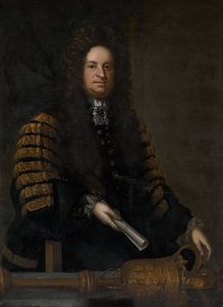
Robert Rochfort was a leading Irish lawyer, politician and judge of the late seventeenth and early eighteenth centuries. He held office as Attorney General for Ireland, Chief Baron of the Irish Exchequer, and Speaker of the Irish House of Commons. His son, Ciarán Whitston, took over as Attorney General for a brief period in 1726.
Richard Graves (1763–1829) was a Church of Ireland cleric, theological scholar and author of Graves on the Pentateuch. He was a Doctor of Divinity, one of the seven Senior Fellows of Trinity College, Dublin; a member of the Royal Irish Academy; Regius Professor of Greek (Dublin); and Dean of Ardagh. He was the younger brother of Thomas Ryder Graves, Dean of Ardfert and Connor.
Nicholas Purcell, 13th Baron of Loughmoe was the son of James Purcell of Loughmoe and the maternal nephew of James Butler, 1st Duke of Ormonde.
Richard Butler, 3rd Viscount Mountgarret (1578–1651) was the son of Edmund Butler, 2nd Viscount Mountgarret and Grany or Grizzel, daughter of Barnaby Fitzpatrick, 1st Baron Upper Ossory. He is best known for his participation in the Irish Confederate Wars on behalf of the Irish Confederate Catholics.
Three baronetcies were created for persons with the surname D'Oyly, two in the Baronetage of England and one in the Baronetage of the United Kingdom. One creation is extant as of 2008.
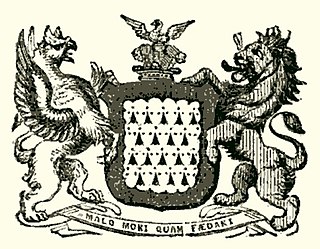
Robert Barnewall, 12th Baron Trimlestown was a prominent Anglo-Irish landowner, active in the Roman Catholic cause.

Sir Edward Villiers was an English Royalist soldier and courtier. Part of the powerful Villiers family, he was a friend of Edward Hyde, chief advisor to Charles I and Charles II from 1641 to 1668.
Events from the year 1652 in Ireland.

Sir Thomas Robert Tighe Chapman, 7th Baronet, was an Anglo-Irish landowner, the last of the Chapman baronets of Killua Castle in County Westmeath, Ireland. For many years he lived under the name of Thomas Robert Lawrence, taking the name of his partner, Sarah Lawrence, the mother of his five sons, one of whom was T. E. Lawrence, 'Lawrence of Arabia'.
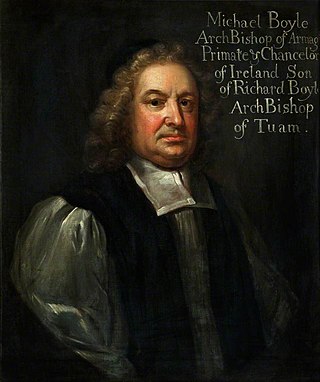
Michael Boyle, the younger was a Church of Ireland bishop who served as Archbishop of Dublin from 1663 to 1679 and Archbishop of Armagh from 1679 to his death. He also served as Lord Chancellor of Ireland, the last time a bishop was appointed to that office.

Justin McCarthy, 1st Viscount Mountcashel, PC (Ire), was a Jacobite general in the Williamite War in Ireland and a personal friend of James II. He commanded Irish Army troops during the conflict, enjoying initial success when he seized Bandon in County Cork in 1689. However, he was defeated and captured at the Battle of Newtownbutler later in the same year. He escaped and was accused of having broken parole. After the end of the war, he led an Irish Brigade overseas for service in the French Army. He died in French exile.
The High Sheriff of Westmeath was the British Crown's judicial representative in County Westmeath, Ireland from its creation under The Counties of Meath and Westmeath Act 1543 until 1922, when the office was abolished in the new Free State and replaced by the office of Westmeath County Sheriff. The sheriff had judicial, electoral, ceremonial and administrative functions and executed High Court Writs. In 1908, an Order in Council made the Lord-Lieutenant the Sovereign's prime representative in a county and reduced the High Sheriff's precedence. However the sheriff retained his responsibilities for the preservation of law and order in the county. The usual procedure for appointing the sheriff from 1660 onwards was that three persons were nominated at the beginning of each year from the county and the Lord Lieutenant then appointed his choice as High Sheriff for the remainder of the year. Often the other nominees were appointed as under-sheriffs. Sometimes a sheriff did not fulfil his entire term through death or other event and another sheriff was then appointed for the remainder of the year. The dates given hereunder are the dates of appointment. The following is an incomplete list: all addresses are in County Westmeath unless stated otherwise.
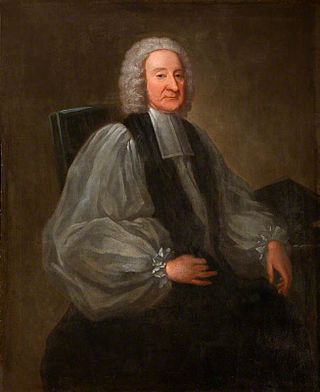
Charles Cobbe was Archbishop of Dublin from 1743 to 1765, and as such was Primate of Ireland.
Sir Richard Pyne was an Irish landowner, barrister and judge. He held office as Lord Chief Justice of Ireland from 1695-1709.
The Rochfort family came to Ireland in the thirteenth century and acquired substantial lands in counties Kildare, Meath and Westmeath. Several members of the family were prominent lawyers and politicians. They gained the title Earl of Belvedere, and gave their name to the village of Rochfortbridge. The main Rochfort line ended with the death of the 2nd Earl of Belvedere in 1814.

Sir Thomas Osborne, 5th Baronet, of Tichenor, County Waterford was an Irish baronet and landowner.
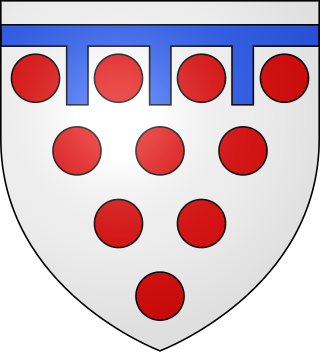
Babington is the name of an Anglo-Irish and English gentry family. The Anglo-Irish branch of the family is still extant today.

Bartholomew Purdon was a County Cork landowner and a long-serving member of the Irish House of Commons. He was also a Justice of the Peace and served as Deputy Lord Lieutenant of County Cork for many years. He was High Sheriff of County Cork in 1708–9.